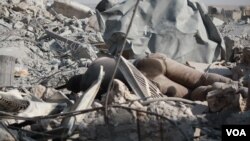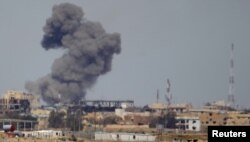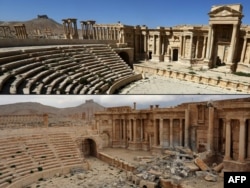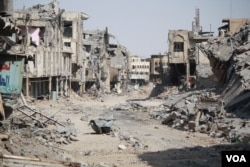Islamic State fighters in Iraq appear to be in disarray and are managing only sporadic counterattacks, after losing the months-long battle for the city of Mosul, says a top U.S. general.
According to Gen. Andrew Croft, the highest ranking U.S. Air Force officer in Iraq, the jihadists are struggling to regroup with their fragmented forces, due to coalition air power restricting one of their past battlefield strengths, the ability to move rapidly and amass fighters.
In 2015, IS demonstrated its mobility, enabling it to counter-punch and score episodic successes to establish a pattern of jihadist wins.
After being ousted from Tikrit, the first substantial city lost by IS, the militants pulled off a series of battlefield counterattacks. They forced Iraqi government forces to abandon their positions in Ramadi, the provincial capital of Iraq’s Anbar province, while launching a powerful attack more than 96 kilometers away on Syria’s Palmyra, the desert town containing one of the world’s most important ancient Roman heritage sites.
Those days appear gone, although the terror group remains dangerous and retains strongholds in the Euphrates River Valley and other parts of Iraq. Croft and other U.S. commanders are not discounting the insurgency IS can still mount, but say air power has given the anti-IS coalition a significant battlefield advantage.
Night and day tracking
“The revolution in warfare has been our unmanned aircraft and the capability to see day and night,” Croft told VOA in a Skype interview.
“We can launch precision strikes in the middle of nowhere, where IS thinks it has a sanctuary and it really doesn’t. We can track them in the desert, we can track them on the water and we can track them in open areas.”
Croft oversees the anti-IS coalition air war in Iraq. He characterized IS attacks now as “sporadic” and said the fighters appear to be “in disarray” with their units “fragmented.”
“We have sensors on the aircraft, all different variations of sensors; in the grand scheme of things, they are relatively inexpensive, so we can build a lot of them and we network them together. That networked warfare with precision sensors is a game-changer,” he said.
He cited a recent skirmish in which Islamic militants tried to cross the Tigris River near Mosul.
“We could tell the IS fighters were really capable, the way they moved tactically on the ground, the way they avoided some of our capabilities; but, we were able to catch seven of the guys in a boat trying to get away from us at night and we were able to launch a precision airstrike.”
Croft says foreign fighters are among the IS forces. “One of the dynamics you see is that foreign fighters can't just blend in with civilians and go to an IDP camp. So the foreign fighters often move around in groups and they will often fight to the death.”
“They are essentially coming to Iraq and dying for nothing,” he added.
Human shields
A jump in reported civilian deaths from U.S.-led coalition airstrikes, since campaigns to capture Raqqa, Syria and Mosul from IS started to escalate, has prompted alarm from Syrian opposition and international rights groups.
Syrian political activists blame the coalition airstrikes for the deaths of at least 370 civilians, more than 100 of them women and children, last month in Syria. That's half of the 740 civilian deaths activists say they documented in June.
Earlier this month, an Amnesty International report detailed the loss of civilian life in the battle for Mosul, documenting 400 civilian deaths between January and mid-May.
While acknowledging IS fighters ruthlessly exploited noncombatants to use them as human shields, Amnesty faulted the coalition for using indiscriminate tactics.
Croft rejects the allegation, saying the coalition has been restrained and striven to minimize civilian deaths. “We have had zero civilian casualties as a goal. Obviously, that’s very difficult to achieve. We do things that are as discriminate as possible, as precise as possible and as proportional as possible.”
He adds, “IS will put snipers on a mosque or a school or use mortars and start firing at us knowing we will not strike those targets because it is a violation of the laws of armed conflict. So, what we will do is use an extremely precise bomb or rocket that has the ability to strike within feet with a very small amount of explosives on it in an attempt to try to neutralize that sniper.”
He says, “We use proportionality as a rule of thumb of whether it is even worth striking and sometimes we will not strike because we don't want to cause any undue damage or civilian casualties.”















